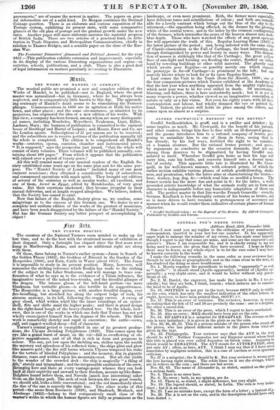lint 3r1ø.
THE TUANER BEQUEST.
I :
The -curators of the National Turners seem minded to make up for lost time and to do the best with the straitened means of exhibition at their disposal. Only a fortnight has elapsed since the first score were MOB in Marlborough House, and now an additional eight are along with them.
Of these, throe belong to Turner's earlier system—Jason in Search of the Golden Fleece (-1802), the Goddess of Discord in the Garden of the Hesperides (1806), and Ruin, Cattle in Water (about 1811). The Jason it is impossible to study in its present position. Many, however, will remember the striking reference which Ruskin has made to the etching of the sulrject in the Liber Studiorum, and will manage to trace con- firmation of what he says as to the evidences of a Titian influence, the imaginative terror of the naked tree-trunks, and the dreadful glimpse of the dragon. The intense gloom of the left-hand portion—no mere blankness, but veritable gloom—is also terrible in its suggestiveness. The Hesperides is a large picture, with another dreadful dragon, ever Xire-breseliinz, but stretched lax along the outpost ledge of rock, his sinuous anatomy, in its lull, following the craggy curves. A sweep of rep cloud, whirl within whirl like the inner soundings of an oyster- shell, flits and shifts amid the higher peaks ; and there is grand design fn the tight-hand bough of the heavy-fruited tree. On the whole, how- ever, this is one of the works in which one feels that Turner has not yet wholly emancipated himself from the dogmas of the schools. The third work is remarkably sketchy, and rapid in execution; the cattle—cows, calf, and ragged-woolled sheep—full of character.
Turner's oentml pesiod is exemplified in one of its greatest produc- tions, the Ulyaaes Deriding Polyphemus (1829). This comes upon the eye like a, mad, bunt•of music on the ear—full to overflowing of ob- jective magnificence, and of all that is rich in form and gorgeous in -colour. The sun, yet low upon the darkling sea, strikes upon the zenith the mystery and splendour of his reflected tints ; the ships glint and glow 'like massive gold ; the fire still burns wherein Ulysses tempered his stake for the torture of blinded Polypheme ; and the monster, dim in gigantic distance, roars find writhes upon his mountain-crest. But all else yields to the wonder of the crowded deck : the ship is magically- "a thing of
fti" tAttely and istitimphant ; and the irrepressible exultation of the crew,
ghere and there ;tt every vantage-point whence they can look
at their captivity and ;inward to their freedom, mounts up like flame. Dolphins -bound before them, and Nereids ,(much less interesting) usher them =AB hXiny path. The arch of rock between the two great vessels, we should add, looks a little conventional ; and the red immediately about the disc of the sun is scarcely the right hue. Two other work§ of this Teried—the seene-from-, toccaecio (1828), and Shadrach, Aleshach, and .Abednego 0832)—belong -to that comparatively small class of the ▪ sterls works in which the human figures are fully as prominent as the landscape, or even more prominent. Both, the former more especially have delicious tones and scintillations of colour ; and both are mud! able for a lovely contrast which brings out the blue of the sky to the uttermost,—the opposition being effected, in the former by the glowing white of the central tower, and in the latter by the crimson conflagration of the furnace, which intensifies the azure of the heaven almost into dark- blue depth. Those who have watched the effects of any great open- fire will appreciate the truth of this. Regulus Leaving Rome (1837) is the latest picture of the period ; and, being infected with the same virus of Claude-classicalism as the Fall of Carthage, the least interesting, al- though distinguished by power and beauty in many ways. The dispoas tion of masses is strikingly like that of the Carthage; the great yellow flare of sun-light and burning sea flooding the centre, flanked on either hand by towering buildings or other solid material. The ghastly caos which awaits poor Regulus—or possibly merely one which sussed, its prototype in far-off Carthage—is prominent to the left; but one scarcely knows where to look for or fix upon Regulus himself, Last comes the Visit to the Tomb (from the lEneid), 1850; one of the four companion-pictures which Turner exhibited at the Academy in that the last year when anything appeared from the mighty right-hand which next year was to be for ever stilled in death. Of uncertainty, blurring, and failure, there is here undoubtedly much ; but it is yet in many respects a power, whether viewed as an imaginative conception of nature or only as a fair vision. Not even his eighty years, with all their contemplation and labour, had wholly dimmed the eye or palsied the hand. Indeed, the picture still holds its place among the others, and comes upon us almost as a surprise.


























 Previous page
Previous page